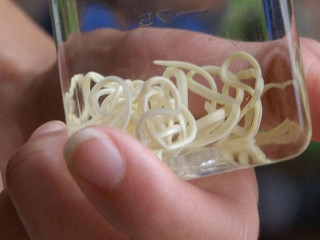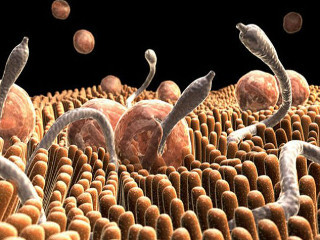
The types of parasites that live in the human body and constitute the greatest threat to it, not all are harmless, as it seems at first glance.
According to research by the World Health Organization, it has been established that 95% of the world's population is infected with various types of parasites.
Any parasite that lives in the human body represents a threat to it. Some are safer, other types of microorganisms of this type can cause a deterioration in human well-being and cause a number of serious diseases. After all, the parasite grows and develops thanks to the best nutrients that it "steals" from humans. And if the sick person was different until the time of the injury in excellent health, monitor their diet, lead an active lifestyle, the presence of parasites in their body may not be noticeable.
But a patient in poor health will only aggravate his situation if he renounces this problem.Soon he will be able to feel all the "pleasures" of the presence of parasites in his body. So many types of parasites that live in the human body are capable of growing throughout life. This often ends with the fact that some types of worms are capable of reaching surprisingly impressive sizes.
As a result, with their large bodies, they can simply block the intestinal lumen, thus causing a host of problems: from simple constipation to varying degrees of organ obstruction. Other types of parasites can produce substances similar to prostaglandins. The human body loses sodium and chloride, as a result, the patient constantly suffers from diarrhea. And some harmful microorganisms can also disrupt the normal permeability of the intestinal mucosa.
These are just a few examples of the harmful effects of parasites on humans. In general, the picture looks even worse.Therefore, at the slightest suspicion of a similar problem, individuals should contact a medical institution for a high-quality, comprehensive examination, treatment recommendations, andprevention.
Parasites are the lower microorganisms of plants and animals that live on or within another individual (called the owner) and feed on it. These microorganisms are distinguished by a simplified body structure, the presence of organs for attachment to the host, an improved development of reproductive organs, the type of amoxibiotic respiration, which is why they exist in an oxygen-free environment.
Types of parasites known to humanity today:
- Worms: according to the structure of the body, they are divided into subspecies such as round and flat worms (in turn, they are divided into classes: trematodes and cestodes).
- The simplest.
- Mycosis.
- Bacteriosis.
Microorganisms-parasites live in the host's body and feed on the food that enters it.
They leave you with practically no useful nutrients and microelements, but they do produce large amounts of toxins, lactic acid and poisons. As a consequence, the host organism becomes contaminated with these dangerous substances. The liver, the intestines suffer, the skin deteriorates, there is complete intoxication of the human body. All useful substances simply do not get to a person, and therefore, sooner or later, the intestines will be disrupted in his body. After all, the process of absorption of nutrients from the intestinal mucosa will stop, the work of your peristalsis will be interrupted.
Ultimately, a person will observe a change in their body weight in either direction. An insufficient amount of nutrients in the body will cause a decrease in immunity. Inflammatory, infectious and even often frequent cancerous diseases will appear. All the organs of the body will cease to function harmoniously. Regarding the general well-being of a person, he will begin to be constantly in a state of hunger, regardless of the amount of food he consumes.
Types of parasites in the human body: classification and description
The types of parasites in the human body are varied and are classified according to different characteristics.
Then, according to the distribution characteristics, there are types of parasites such as:
- Ubiquitous. They live everywhere.
- Tropical. It is found only in the tropics.
Based on the specificities of the biological and epidemiological sense, parasitic microorganisms are divided into:
- Geohelminths. The first stages of life take place in the human body and later, in an inanimate substrate.
- Biohelminths. The biological cycle of development of a certain creature begins and ends exclusively within living beings, but not in a person. Biohelminths have terminal hosts, in which they develop to sexual maturity, and intermediate hosts, in which the larvae are in the larval stage or reproduce nonsexually. In most cases, a person is the final host for these microorganisms, but sometimes they become an intermediate host.
- Get in touch with the helminths. Leaves the human body as a nearly mature or fully mature individual. As a result of this, it is possible for another person to "get an infection" from the first person.
Depending on the location characteristics, parasitic microorganisms of the following types are isolated:
- Translucent, which lives in the intestines and other cavities of the human body.
- Tissue that lives in the epithelium of the human body.
Depending on the location, all types of parasites in the human body are divided into:
- In the open air. These include, for example, mosquitoes and horseflies.
- Internal. These include: round, flat, and tapeworms.
- Bacteriosis. For example, leptospira and staph.
- Protozoa or protozoa. For example, amoeba or giardia.
- Mycosis (or fungi). For example, candida.
There are many varieties of human worms that live and develop inside your organs. Let's describe the options that are more common than others later.

Ascaris.It causes the development of a dangerous disease: ascariasis. Helminths have a round and elongated body, parasitizing the interior of the human small intestine. It has a complex development cycle: entering the throat, it migrates through the trachea, lungs, right heart, liver to the intestines.
All this time it grows, multiplies, populating all organ systems with new individuals. Its presence causes serious changes in the patient's health status. Hepatitis, cirrhosis of the liver can develop, degeneration of the cells of this organ can begin, bronchitis and many other equally dangerous diseases of various organs can be caused. The parasite doesn't live long, only about a year, then it dies. But due to high reproduction rates and the rapid increase in the number of harmful microorganisms in the human body, it can be quite difficult for patients to recover.
Trichinella.They cause the development of a serious disease for humans: trichinosis. The infection occurs after a person ingests insufficiently roasted pork, boar and bear in their food. Once in the stomach, the larva migrates to the small intestine, where it begins its active growth and reproduction. The larvae it generates migrate to all human organs, causing muscle calcination, severe allergies, severe damage to the lungs, heart, and liver. Often times, patients with a severe degree of infection and inattention to their health simply die.
Pig tapeworm.Human infection occurs after eating the larvae of this parasite found in pork. This is why it is so important to cook meat well before eating it. The individual's larval form enters the small intestine through the stomach and grows into an adult in this organ. Sometimes the parasite is located directly in the intestine, it also usually affects other organs, causing development.
Cysticercosis.When it enters the brain and eyeball of a person, it causes irreversible consequences. For these reasons, it is necessary to treat patients with such a complex problem quickly and efficiently, although we note that a small number of antiparasitic drugs demonstrate high efficiency in the fight against swine tapeworms. This aggravates the situation significantly. But you cannot doubt, otherwise death is inevitable.






































